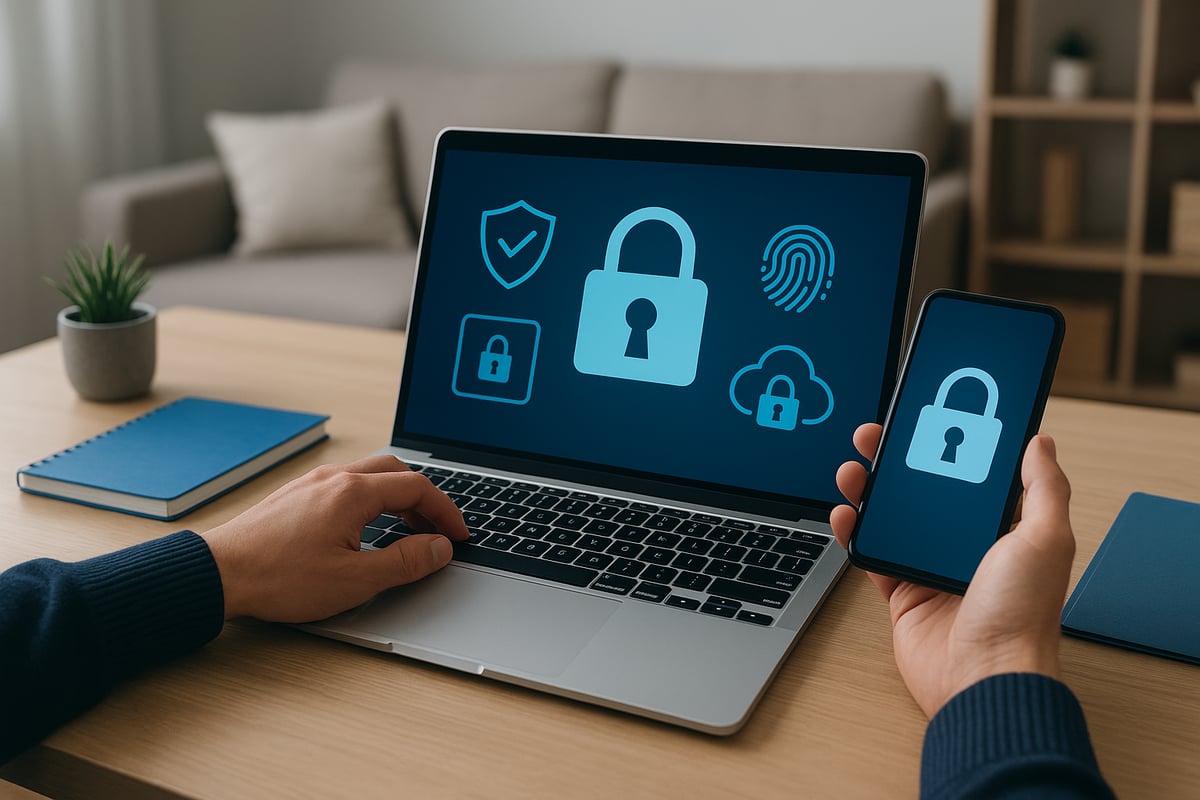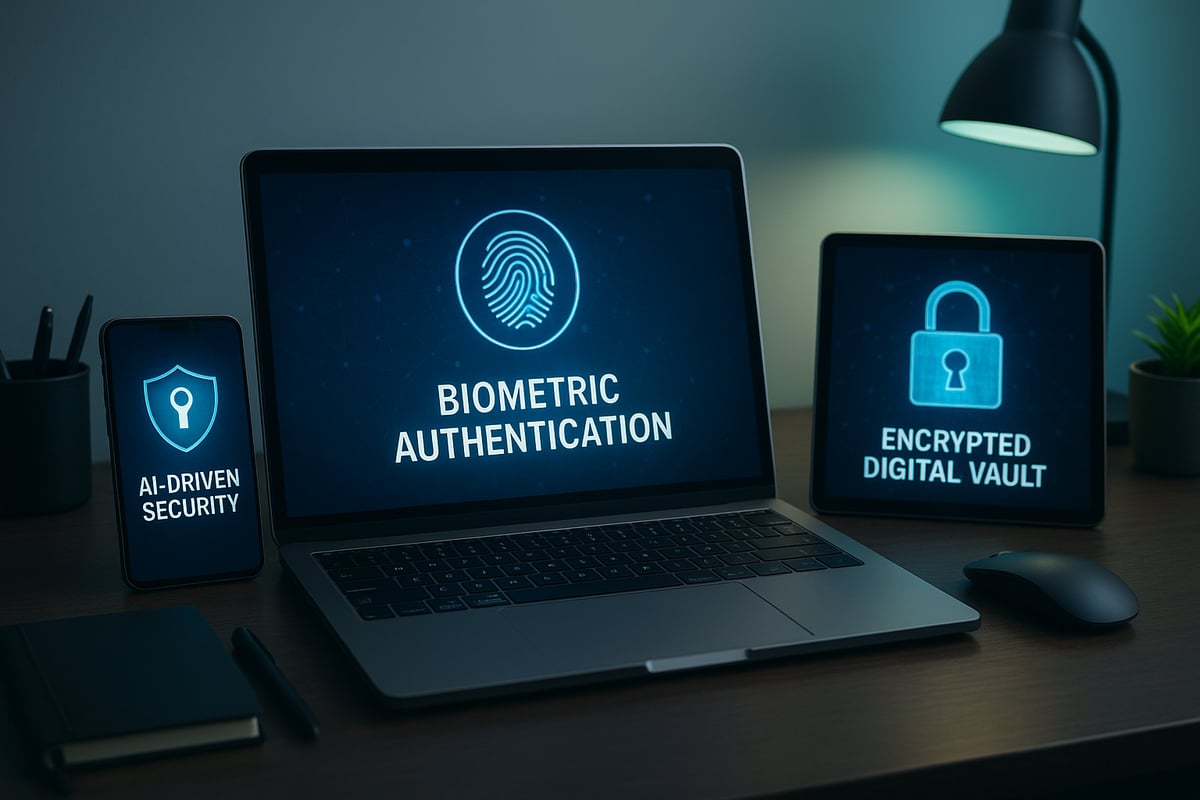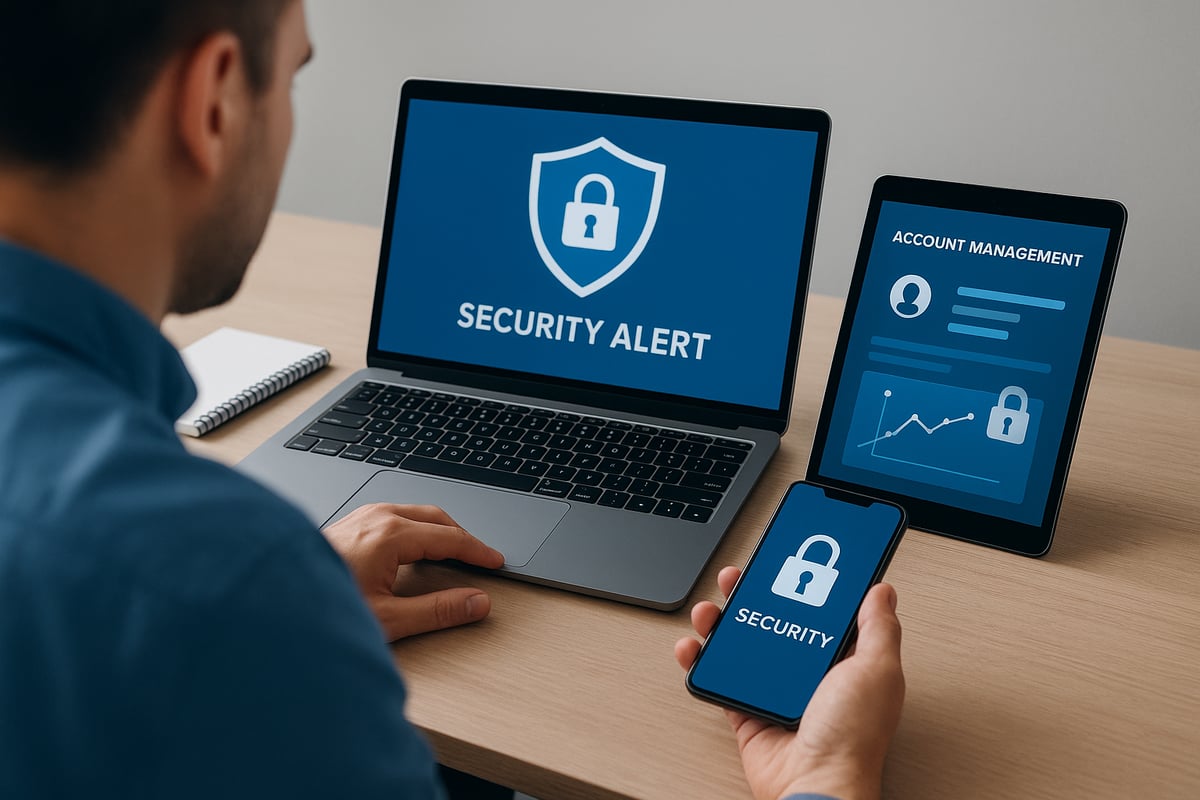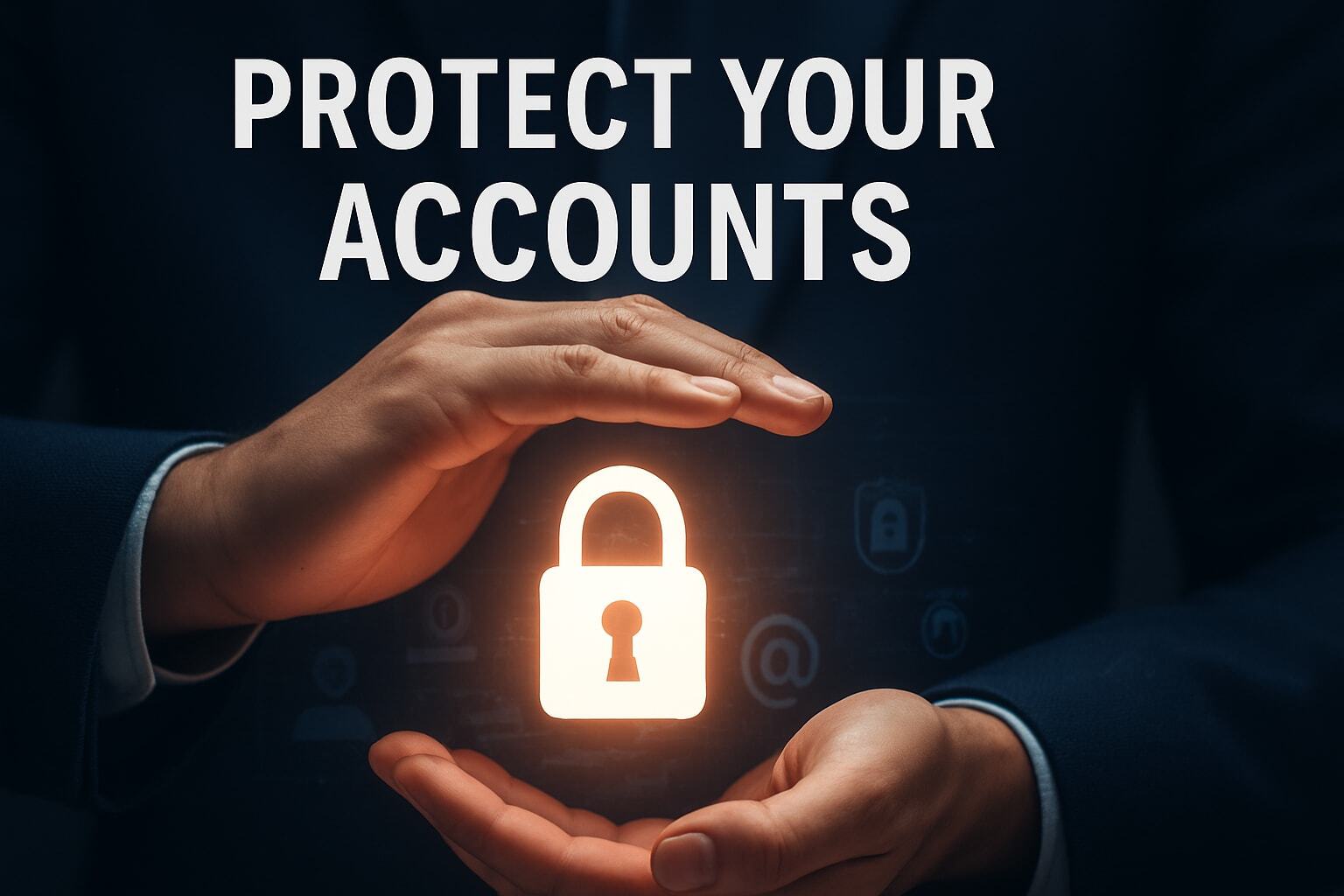Protect Your Accounts: The Essential Guide for 2025
In 2025, cybercriminals are using advanced tools and tactics, making every online account a potential target. Recent years have seen a surge in data breaches, identity theft, and account takeovers, leaving individuals and families vulnerable to lasting financial and personal harm.
The need to protect your accounts has never been more urgent. A single compromise can lead to lost savings, damaged reputations, and ongoing stress. This article provides a clear, practical guide to help you stay ahead of evolving threats.
You will learn the latest strategies to secure your digital life, from understanding modern risks to implementing advanced safeguards. We will cover essential security steps, advanced protection measures, managing your digital footprint, and maintaining ongoing vigilance. Let’s begin your journey to stronger account security.
Understanding Modern Account Threats in 2025
The digital threat landscape is evolving rapidly, putting everyone at greater risk. To truly protect your accounts, it is essential to understand the tactics cybercriminals use, the vulnerabilities they exploit, and the warning signs that signal danger. Let’s break down what you need to know for 2025.

The Evolving Landscape of Cyber Threats
In 2025, cybercriminals are leveraging AI-driven phishing schemes, credential stuffing, and SIM swapping to breach personal and business accounts. The past year has seen a surge in ransomware, with the US becoming ransomware capital of the world, highlighting how attackers now target individuals as well as organizations. Major data breaches in 2024 exposed millions of users, showing that no one is immune. To protect your accounts, you must stay informed about these evolving tactics and understand the risks they pose to your digital identity.
Most Common Vulnerabilities in Personal Accounts
The most frequent entry points for attackers remain weak and reused passwords, outdated software, and human error through social engineering. Statistics reveal that over 80 percent of breaches are linked to compromised credentials, making password hygiene critical to protect your accounts. Unpatched devices and old software also provide easy access for cybercriminals. Social engineering, such as convincing emails or texts, can trick even tech-savvy individuals. Regularly updating your defenses is vital against these persistent vulnerabilities.
The Cost of Account Compromise
Falling victim to a cyberattack can result in significant financial and emotional harm. In 2024, the average personal loss per breach exceeded $1,200. Beyond monetary damage, identity theft can harm your reputation and cause long-term issues like credit score reductions or legal complications. The impact can linger for years, affecting job prospects and personal relationships. To protect your accounts, it is crucial to recognize the full scope of these risks and take action before you become a statistic.
|
Impact Type |
Example Losses |
|---|---|
|
Financial |
$1,200+ per breach |
|
Emotional |
Stress, anxiety |
|
Reputational |
Damaged relationships |
High-Risk Accounts: What Needs Extra Protection
Certain accounts are especially attractive to cybercriminals. Email, banking, social media, and cloud storage accounts often store sensitive or financial information. If compromised, these accounts may lead to identity theft or financial fraud. For example, a social media account takeover can result in fraudulent transactions or damaging posts. To protect your accounts, prioritize security for those with access to your money, private data, or vital services, and use extra layers of defense wherever possible.
Recognizing Early Warning Signs
Early detection is vital to protect your accounts from being misused. Warning signs include unexpected password reset emails, login notifications from unfamiliar locations, unauthorized transactions, or new devices accessing your accounts. If you notice any of these, act quickly by changing your passwords, reviewing account activity, and contacting support. Staying alert and responding fast can minimize the harm and prevent further compromise of your digital identity.
Essential Steps to Secure Your Accounts
Securing your digital presence requires more than just a strong password. To truly protect your accounts, follow these essential steps. Each practice addresses a unique aspect of online security, helping you stay ahead of evolving threats in 2025.

Step 1: Strengthen Your Passwords
The foundation to protect your accounts is setting up strong, unique passwords for every login. Avoid using the same password across multiple sites, as this increases your vulnerability. A password manager is essential in 2025, storing complex passwords securely and generating new ones when needed.
Here's a quick comparison of popular password managers:
|
Password Manager |
Auto-Generate |
Cross-Device Sync |
Breach Alerts |
|---|---|---|---|
|
LastPass |
Yes |
Yes |
Yes |
|
1Password |
Yes |
Yes |
Yes |
|
Bitwarden |
Yes |
Yes |
Yes |
By investing in a trusted solution, you can protect your accounts without struggling to remember dozens of credentials.
Step 2: Enable Multi-Factor Authentication (MFA)
Multi-factor authentication adds another critical layer to protect your accounts. MFA requires you to verify your identity using two or more methods, such as a password plus a code from an app or a hardware token.
Types of MFA include:
- SMS codes
- Authenticator apps (like Google Authenticator)
- Hardware security keys
According to the Microsoft Security Report 2024, MFA blocks 99.9% of automated attacks. Activating MFA wherever possible is a simple yet powerful way to protect your accounts.
Step 3: Regularly Update and Patch Devices
Outdated software is a common entry point for cybercriminals. To protect your accounts, always keep your operating system, browser, and apps updated. Many breaches in 2024 exploited vulnerabilities in unpatched applications.
Set your devices to auto-update where possible. Prioritize patches for security updates. Staying current ensures hackers have fewer opportunities to exploit your digital life.
Step 4: Monitor Account Activity
Vigilance is key when you want to protect your accounts. Set up account alerts for suspicious activity and regularly review login histories and connected devices. Many platforms let you see recent sign-ins and locations.
Consider using monitoring tools that notify you of unusual access attempts. According to the Global Cybersecurity Index 2024, staying aware of global trends and readiness can further strengthen your defenses. Taking these steps helps you detect threats before they cause real harm.
Step 5: Secure Recovery Options and Backup Plans
If you ever lose access, recovery options can make or break your ability to protect your accounts. Regularly update your recovery email and phone number. Use secure backup methods, such as encrypted cloud storage, for critical information.
Popular backup solutions:
- Encrypted cloud storage (Google Drive, iCloud, OneDrive)
- External hard drives with encryption
- Secure USB drives
By preparing for the unexpected, you ensure your digital life is resilient and recoverable.
Step 6: Beware of Phishing and Social Engineering
Cybercriminals increasingly use phishing and social engineering to bypass technical defenses. To protect your accounts, learn to spot suspicious emails, messages, and websites.
Common tactics in 2025 include:
- Fake login pages mimicking real sites
- Urgent requests for personal information
- Impersonation of trusted contacts
IBM X-Force Threat Intelligence reports that phishing caused 36% of breaches in 2024. Stay skeptical, verify every request, and never rush into sharing sensitive information.
Step 7: Protect Sensitive Documents and Instructions
Critical documents like estate plans, digital wills, and emergency instructions require special care. To protect your accounts and legacy, store these files in encrypted drives or digital vaults with strict access controls.
Digital vaults offer:
- End-to-end encryption
- Multi-user access management
- Emergency sharing features
In an emergency, having these instructions securely stored ensures your wishes can be carried out without risk of unauthorized access.
Advanced Protection Measures for 2025
The digital landscape in 2025 demands advanced strategies to protect your accounts. With cyber threats evolving rapidly, basic security steps are no longer enough. Implementing these advanced protection measures will help you stay ahead of attackers and ensure your digital safety.

Using Passwordless Authentication
Passwordless authentication is set to redefine how you protect your accounts in 2025. Instead of relying on traditional passwords, this method uses biometrics like fingerprints or facial recognition, and hardware security keys.
These solutions reduce the risk of stolen credentials, as there is no password to leak or phish. Major tech platforms now support passwordless logins, making them both convenient and secure for users. Adoption rates have surged as people realize the benefits of faster access and fewer vulnerabilities.
A quick comparison table of passwordless options:
|
Method |
Security Level |
User Experience |
|---|---|---|
|
Biometrics |
High |
Seamless |
|
Security Keys |
Very High |
Simple, portable |
|
Magic Links |
Moderate |
Easy, email-based |
Choosing the right method helps protect your accounts against modern threats.
Leveraging AI-Based Security Tools
AI-based security tools are essential to protect your accounts from sophisticated attacks. These tools can identify unusual login patterns, detect phishing attempts, and respond to threats in real time.
By integrating large language models with threat intelligence, organizations and individuals can gain a proactive edge. For example, LLM-Assisted Proactive Threat Intelligence demonstrates how AI-driven systems can spot and neutralize new threats before they cause harm.
AI tools also reduce breach detection times and automate responses, making it easier to protect your accounts even as attackers grow more advanced.
Identity Theft Protection Services
Identity theft protection services are a powerful way to protect your accounts in 2025. These services offer features such as credit monitoring, dark web scanning, and identity recovery support.
Top providers include options for insurance coverage and rapid alerts if your information appears in suspicious locations. A comparison of leading services can help you choose the best fit for your needs:
|
Service |
Credit Monitoring |
Dark Web Scan |
Insurance Coverage |
|---|---|---|---|
|
Service A |
Yes |
Yes |
$1M |
|
Service B |
Yes |
No |
$500K |
|
Service C |
Yes |
Yes |
$1M |
Using these services gives you peace of mind and an extra layer to protect your accounts.
Secure Digital Vaults for Critical Information
Digital vaults are essential for safely storing sensitive information and help protect your accounts from unauthorized access. These vaults use strong encryption and fine-grained access controls to secure estate plans, legal documents, and emergency instructions.
When choosing a digital vault, look for features like multi-factor authentication, emergency access for trusted contacts, and regular security audits. In the event of an emergency, digital vaults make it easy for loved ones to retrieve crucial information without compromising your security.
Protect your accounts by ensuring that all critical data is stored in a reliable and secure digital vault.
Managing Access for Family and Trusted Contacts
Preparing for emergencies is a key part of advanced account protection. To protect your accounts, set up secure access protocols for family members or trusted individuals who may need to manage your digital assets.
Use encrypted sharing methods and avoid writing down passwords on paper. Legacy planning tools provided by some platforms allow you to designate digital heirs or emergency contacts. This approach ensures that your accounts remain protected even if you are unable to manage them yourself.
Regularly review who has access and update permissions as needed to maintain security.
Keeping Up with Security Trends and Best Practices
Staying informed is critical if you want to protect your accounts against new and emerging threats. Follow reputable cybersecurity blogs, subscribe to industry advisories, and participate in security awareness training.
Engage with online communities and forums to share experiences and learn about the latest protection techniques. Make a habit of reviewing your security settings and adopting new tools as they become available.
Continuous learning and adaptation are essential to protect your accounts and maintain your digital safety in 2025.
Managing Your Digital Footprint
Your digital footprint is larger than you might think. Every account, profile, and post leaves a trace that could be exploited if not managed carefully. To truly protect your accounts in 2025, you must take control of your online presence and minimize unnecessary exposure. With cyber threats rising globally, including a surge in cyberattacks on US utilities, managing your digital footprint is more important than ever.

Auditing and Minimizing Account Exposure
Start by reviewing all your active and dormant accounts. Many people forget about old accounts that still hold personal data. These unused accounts are prime targets for attackers who seek easy access points.
- Make a list of every account linked to your email addresses.
- Delete or deactivate accounts you no longer use.
- Update passwords and security settings for accounts you keep.
Taking these steps can significantly reduce your online risk. Regular audits help protect your accounts by closing loopholes that hackers might exploit.
Limiting Personal Information Online
Oversharing on social media and public forums can expose sensitive details. Adjust your privacy settings on all major platforms to restrict who can see your information.
- Avoid posting your full birth date, address, or travel plans.
- Review and update privacy settings every few months.
- Be cautious about accepting friend or connection requests from unknown people.
Studies show that 60% of identity theft cases begin with publicly available information. By limiting what you share, you protect your accounts from being compromised through social engineering.
Controlling App and Third-Party Access
Many apps and services request access to your accounts, sometimes unnecessarily. Periodically review which apps have permissions and revoke access for those you no longer trust or use.
- Open your account settings and check connected apps.
- Remove outdated or suspicious third-party services.
- Be wary of granting broad permissions to new applications.
OAuth vulnerabilities and data leaks often occur due to unchecked app integrations. Regularly controlling these connections is a key way to protect your accounts.
Safe Use of Public Wi-Fi and Shared Devices
Public Wi-Fi networks and shared computers are common entry points for cybercriminals. Avoid logging into sensitive accounts over unsecured networks whenever possible.
- Use a VPN when connecting to public Wi-Fi.
- Always log out of accounts on shared devices.
- Clear browsing data after each session.
Following these best practices helps protect your accounts from being intercepted or accessed by unauthorized users in public spaces.
Digital Detox: Periodic Security Checkups
Schedule regular security reviews to maintain strong defenses. Use checklists to examine your account and device security. This habit ensures that you promptly address vulnerabilities before they become serious issues.
- Set reminders for quarterly or biannual digital checkups.
- Update passwords, review account activity, and patch software.
- Remove unnecessary apps and accounts during each review.
Ongoing digital hygiene is essential to protect your accounts and secure your digital life in a constantly evolving threat landscape.
Ongoing Vigilance: Staying Ahead of Threats
Remaining vigilant is crucial if you want to protect your accounts from evolving cyber threats. As technology advances, so do the tactics used by attackers. By embracing ongoing vigilance, you create a strong line of defense that adapts to new risks and ensures your digital safety is never left to chance.
Recognizing and Responding to New Threats
Cyber threats are constantly shifting, making it more important than ever to stay informed. Following cybersecurity news sites and subscribing to security alerts can help you spot new risks early. When new vulnerabilities are announced, quick action like updating software or changing passwords can make a significant difference.
For example, zero-day exploits can spread rapidly. If you notice unusual activity or receive alerts from trusted sources, immediately review your accounts for suspicious changes. To protect your accounts, always act swiftly and be ready to implement recommended security patches.
Building a Security-First Mindset
A security-first mindset means making digital protection a daily habit. Encourage everyone in your household or organization to recognize the value of strong security practices. Regularly discuss new threats and simulate phishing attempts to keep awareness high.
Training sessions and online resources can help reinforce these habits. When you prioritize a security-first approach, you protect your accounts more effectively and reduce the risk of falling victim to common scams.
Incident Response: What to Do If Compromised
If you suspect an account breach, immediate action is vital. Start by changing all passwords associated with the compromised account. Notify your bank, email provider, or any affected services to freeze access if needed.
Next, check for unauthorized transactions or messages and report them to the relevant institutions. Having a clear incident response checklist helps you protect your accounts quickly and minimize damage during a stressful event.
Legal and Regulatory Considerations in 2025
New privacy laws and regulations are reshaping digital security requirements. Familiarize yourself with updates to frameworks like GDPR and CCPA, especially if you manage personal or business accounts. These laws often require stronger authentication and timely breach notifications.
Staying compliant not only helps you avoid penalties but also signals to others that you take security seriously. As you protect your accounts, ensure your practices align with the latest legal standards for maximum protection.
Future-Proofing Your Accounts
Cybersecurity never stands still. Prepare for new authentication technologies, such as biometrics and passwordless logins, which offer additional security layers. Keep an eye on developments in quantum computing, as these could eventually impact current encryption methods.
Stay flexible and ready to update your security tools as technology evolves. By doing so, you protect your accounts against both current and future threats, ensuring long-term digital safety.
Resources and Tools for Continuous Protection
To stay ahead, use reputable apps and services designed to protect your accounts. Consider password managers, identity theft protection services, and real-time monitoring tools. For up-to-date guidance, follow trusted sources such as Krebs on Security or official government advisories.
Join community forums and attend webinars to learn from experts and peers. Leveraging these resources helps you protect your accounts continuously, keeping your digital life secure in an ever-changing threat landscape.
After exploring the growing risks and practical steps to shield your digital life in 2025, one thing becomes clear—you need more than just strong passwords and good habits. Organizing and protecting your most important digital information gives you true peace of mind, especially for your family’s future. If you’re ready to take the next step, IronClad Family offers secure digital vaults and emergency planning tools that make it easy to safeguard documents, estate plans, and vital instructions.
You can try it yourself and see how simple digital security can be—Start 14-Day Free Trial.

Sahar Lester
Sahar Lester is the Founder and CEO of IronClad Family, a company dedicated to helping families and businesses safeguard their most valuable assets through secure digital vaults. With a master’s degree in Security Technologies from the University of Minnesota and experience spanning cybersecurity, leadership, and international commerce, Sahar bridges the gap between innovation and protection. She also serves as an adjunct professor at Metropolitan State University, mentoring the next generation of cybersecurity professionals.



